
Scania AB, stylised SCANIA in its products, is a major Swedish manufacturer headquartered in Södertälje, focusing on commercial vehicles—specifically heavy lorries, trucks and buses. It also manufactures diesel engines for heavy vehicles as well as marine and general industrial applications.
Scammell Lorries Limited was a British manufacturer of trucks, particularly specialist and military off-highway vehicles, between 1921 and 1988. From 1955 Scammell was part of Leyland Motors.

Tidaholms Bruk was a Swedish a vehicle manufacturer. Originally a woodworking and cart manufacturing business founded in the Middle Ages, the company evolved along the centuries and entered the automotive industry with the creation of the Tidaholm car in 1903. Their early models include Tor I, Tor II, and TB, known for their reliability. Facing financial difficulties during the Great Depression, the company eventually closed in the early 1930s. While the company is no longer in operation, it played a significant role in Sweden's automotive history.
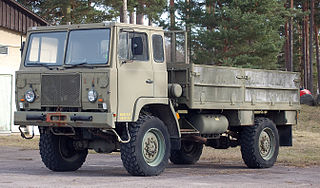
The Scania SBA111, designated Terrängbil 30, is a military all-wheel drive cross-country truck designed and manufactured by Scania division of Saab-Scania for the Swedish Armed Forces. Full name is Special Bulldog Allwheeldrive, generation 1, 11-liter diesel engine.

The Piaggio Porter is a cab over microvan and pick-up produced and sold by the Italian company Piaggio since 1992 under the Piaggio Commercial Vehicle brand.

Vanajan Autotehdas Oy (VAT) was a producer of heavy vehicles based in Hämeenlinna, Finland. The company was founded as Yhteissisu Oy in 1943 by the Finnish government and a number of major Finnish companies with the aim of producing lorries and buses for the Finnish Defence Forces. World War II was over before the company could start series production; it was renamed Vanajan Autotehdas and the marque became Vanaja. Subsequently, the production consisted of outdated lorry models, partly built from military surplus materials. After overcoming initial difficulties, the company modernised its products, became profitable and grew until the mid-1950s. Many major components, including engines, were imported. Diesel engines became widely available in 1955, and in 1959 VAT introduced its most significant innovation, the full load lifting tandem axle mechanism, which improved off-road capability significantly; the system is now used in Sisu vehicles.

The Volvo LV71-series was a medium size truck produced by Swedish automaker Volvo between 1932 and 1935.
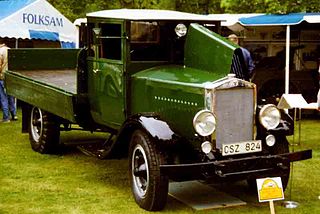
The Scania-Vabis 314/324/325 was a series of trucks produced by Swedish automaker Scania-Vabis between 1925 and 1936.
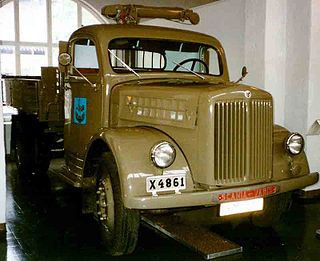
The Scania-Vabis L10/L40/L51 was a series of trucks produced by Swedish automaker Scania-Vabis between 1944 and 1959.

The Scania-Vabis L55/L56/L66 was a series of trucks produced by Swedish automaker Scania-Vabis between 1959 and 1968.
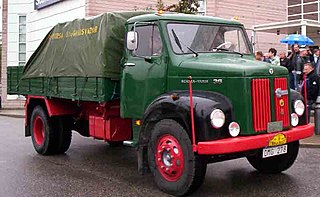
The Scania-Vabis L36 was a medium sized truck produced by Swedish automaker Scania-Vabis between 1964 and 1968.

The Scania-Vabis L20/L60/L71 was a series of heavy duty trucks produced by Swedish automaker Scania-Vabis between 1946 and 1958.
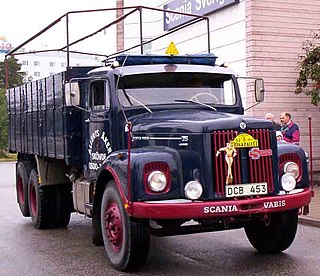
The Scania-Vabis L75/L76 was a series of heavy duty trucks produced by Swedish automaker Scania-Vabis between 1958 and 1968.

Sisu M-series is a 2–4-axle forward control lorry model series made by the Finnish heavy vehicle producer Suomen Autoteollisuus (SAT) in 1969–1984. The series consists of 4×2-driven M-161, 6×2-driven M-162, 6×4-driven M-163 and 8×2-driven M-168. Typical applications were logging trucks, tankers and long-distance transportation haulers which pulled conventional and semi-trailers. The permissible payloads varied from ca. 9 tonnes up over 18 tonnes.

The Moto Guzzi Triporteurs were wheeled transport motorcycles (triporteurs) of the Moto Guzzi brand. In Italy, they are called "motocarri".

Maskinfabriks-aktiebolaget Scania, translates Machine Factory Limited Company Scania, was a Swedish bicycle manufacturer established in Malmö in 1900. The company rapidly expanded to manufacture other products like precision gears, vacuum cleaners, automobiles, trucks and engines. The company was in 1911 merged with Vabis, to form Scania-Vabis.
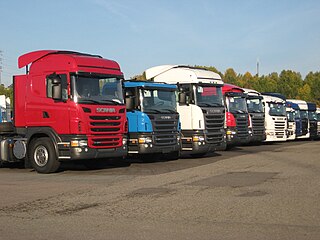
The Scania PRT-range, also referred to as new truck range or Scania's truck range, is the current range of trucks produced by the Swedish commercial vehicle manufacturer Scania. It was first introduced as the successor to the 4-series in spring 2004 with the high forward control cab Scania R-series, followed by the low forward control cab Scania P-series and bonneted cab Scania T-series later in the year. The bonneted model was discontinued in 2005. In 2007 the Scania G-series, a medium forward control cab was introduced and was derived from the R-series. The entire range is modular, giving a wide range of different configurations for different types of trucks. The trucks are available with engines ranging from a 9-litre I5 to a 16-litre V8, with the V8 only being available in the higher model. A second generation launched in August 2016, first was the Scania S-series being the first flat-floor model. In December 2017, a low-end version of the second generation, the Scania L-series, also launched.

The SAMIL 20 is a 2-ton cargo vehicle produced in South Africa in the mid-1980s and was used as the primary light cargo carrier of the South African National Defence Force. The vehicle design is based on the German Mercedes Unimog chassis and Mark I of this vehicle was based on the Magirus Deutz 130M7FAL 4x4 truck. In Mark II, the engine was replaced with an upgraded South African built water cooled diesel engine. The vehicle is still in use with the SANDF.

The SAMIL 50 is a 4x4 6-ton (load) truck.

The Mack AC was a heavy cargo truck designed in the 1910s by the American manufacturer Mack Trucks. Introduced in 1916, the Mack AC saw extensive service during the First World War with the British and American armed forces, in British service it was given the nickname the "Bulldog" which led to Mack adopting the Bulldog as its corporate symbol.




















